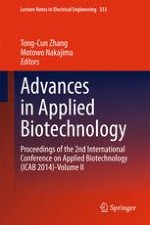2015 | OriginalPaper | Buchkapitel
32. Optimization of Cultural Conditions for Extracellular Polymeric Substances (EPS) Production by Burkholderia Using Response Surface Methodology
verfasst von : Baojiang Sun, Peipei Han, Ruyu Tao, Qixiu Pang, Shiru Jia
Erschienen in: Advances in Applied Biotechnology
Verlag: Springer Berlin Heidelberg
Aktivieren Sie unsere intelligente Suche, um passende Fachinhalte oder Patente zu finden.
Wählen Sie Textabschnitte aus um mit Künstlicher Intelligenz passenden Patente zu finden. powered by
Markieren Sie Textabschnitte, um KI-gestützt weitere passende Inhalte zu finden. powered by
